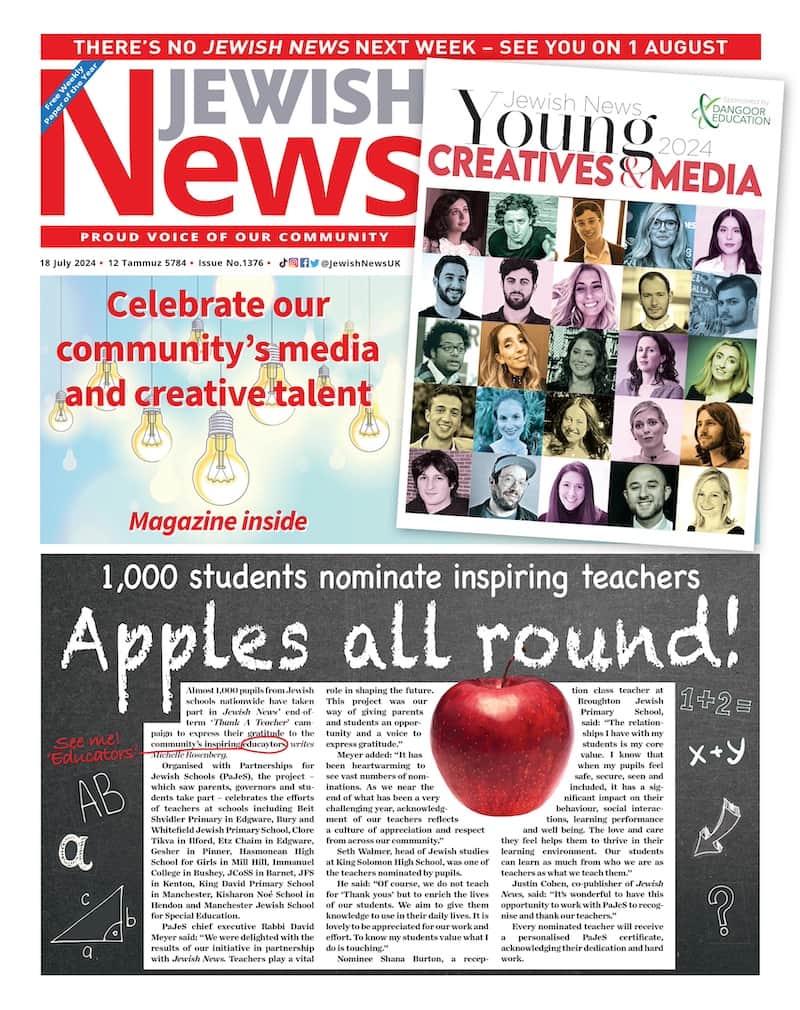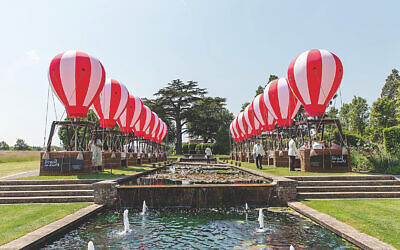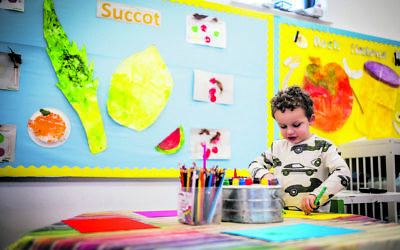INTERVIEW: ‘Being Chief Rabbi does not come naturally. It demands total dedication’
Newly-knighted Sir Ephraim Mirvis sits down with Richard Ferrer to reflect on the moments in his life that influence his philosophy of inclusion, as he prepares to mark 10 years in the role.
Richard Ferrer has been editor of Jewish News since 2009. As one of Britain's leading Jewish voices he writes for The Times, Independent, New Statesman and many other titles. Richard previously worked at the Daily Mail, Daily Mirror, edited the Boston Jewish Advocate and created the Channel 4 TV series Jewish Mum Of The Year.
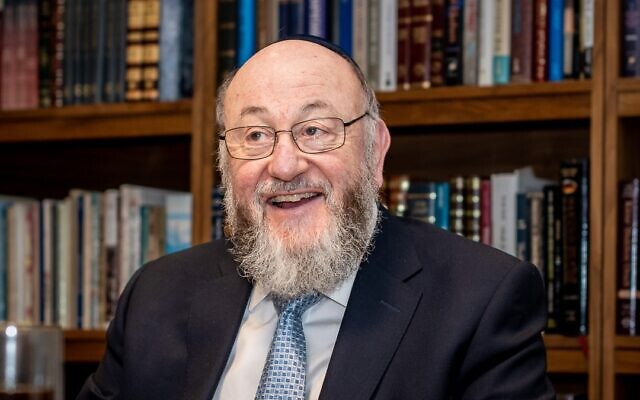
Ten years, five prime ministers and one knighthood later, the Chief Rabbi can look back with pride on a decade defined by one overarching goal – making modern Orthodox Judaism as inclusive as possible.
His illustrious predecessor, Rabbi Lord Sacks, was undoubtedly a Sir Alex Ferguson-sized act to follow, but Ephraim Mirvis has adeptly presided over a transformational decade in which halachic hot potatoes have been tackled head-on.
He wasted no time in setting the tone of his tenure, becoming the first sitting Chief Rabbi to speak at Limmud conference, where he received a standing ovation. He set about expanding women’s roles in the United Synagogue through his Ma’ayan and Neshama programmes and appointed its first female halachic adviser. He issued a landmark guide on the wellbeing of LGBT+ children in Orthodox schools and, through his Ben Azzai programme, inspires young leaders to tackle global issues such as climate change and the refugee crisis.
Through Shabbat UK, he encourages non-observant Jews to keep the day of rest at least once a year and, with Project Welcome, got people back into shul post-pandemic. And, just months ago, he was the first Chief Rabbi in his office’s 318-year history to make an official visit to an Arab state.
Everything this Chief Rabbi does is guided by his philosophy of inclusion.
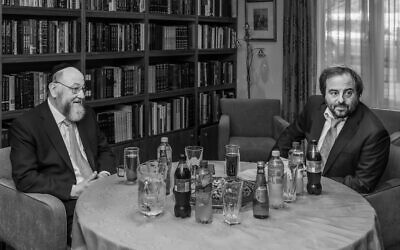
I’ve known him in my role as Jewish News editor long enough to know he’s most as ease talking about work rather than anything mildly personal. A deeply private man in a relentlessly public role, it’s a contradiction he’s learned to live with. “I don’t like talking about myself,” he admits, midway through a lengthy chat in which I try to make him talk about himself as often as seems polite.
“Being Chief Rabbi did not come naturally to me. I don’t think it comes naturally to anyone. The enormity of the task requires exceptional seriousness. I love it, I enjoy it and it’s a huge privilege. But does it come naturally? No. Leadership roles, especially religious ones, demand dedication and a sense of responsibility. It takes time and effort to develop the skills to be a successful leader.”
Rewind the start of our lunchtime together and the Chief Rabbi warmly greets photographer Adam and me at the front door and ushers us into his book-lined study – its centrepiece being a precious Czech Torah scroll rescued from a community destroyed during the Holocaust.
Being Chief Rabbi did not come naturally to me. I don’t think it comes naturally to anyone. The enormity of the task requires exceptional seriousness.
We sit at a table hospitably strewn with nuts, chocolate and bottled drinks. “Now, the last time you were here you took your coffee black,” the Chief Rabbi tells me. (Impressive. Even my wife pours milk in my Americano).
We begin at the beginning, with the young Ephraim Mirvis growing up amid the injustices of apartheid South Africa. How did this brutal system shape his formative years?
“Apartheid was central to my existence,” he reflects, leaning back in his chair, his Rainbow Nation accent tinged with a hint of Hendon. “Many people still don’t appreciate the true evils of this system, the depths to which it sank.
“Every day I travelled to and from school on a train with eight coaches, the front four for whites only. Every railway station had separate black and white entrances, seating and ticket offices. A white ambulance couldn’t save a black life and an interracial relationship was a jailable offence.”
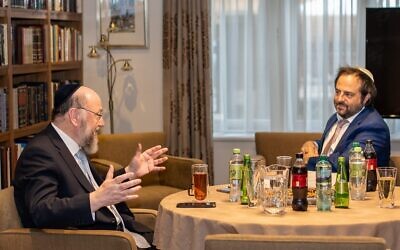
His family publicly opposed the regime, often at a cost. “Being against apartheid wasn’t just a moral decision, it was a Torah stand. It was the antithesis of what Torah life demands of us. My father (Rabbi Dr Lionel Mirvis) was a lecturer at Cape Town University, where he took part in protests. I remember him coming home from one almost blinded by tear gas.
“My mother (Freida), in addition to being a rebbetzin, was principal of South Africa’s only pre-school teacher training college for people of colour. She invited colleagues to my brother Jonathan’s barmitzvah and guests complained about black people being there. One couple insisted on moving to another table. Imagine that happening today! But for us it was how we lived, what we endured.
“A lovely lady called Phyllis, a black friend of the family who also worked for us, named her boy after me. I wonder where little Ephraim is these days?”
He continues: “One of my proudest memories was seeing my great-uncle, Benny Eidelman, a partner at the legal firm that employed Nelson Mandela at a time when other firms would not, mentioned in Mandela’s autobiography A Long Walk to Freedom. The pages with Mandela’s words of appreciation are on display in the Jewish Museum in Cape Town.”
Having experienced a segregated society, how does he respond to apartheid accusations against Israel? “It’s an outright lie to suggest anything in Israel is comparable to the cruel and evil system I grew up in. You just have to visit a hospital to see the real Israel. “When our daughter was ill she was treated by the Arab head of general surgery, a great man named Professor Ahmed Eid.
I didn’t know what KBE (Knight of the Most Excellent Order of the British Empire) stood for so I Googled it. It is wonderful, humbling recognition of the importance of the Jewish community in this country.
“In that hospital, around 40 percent of the patients tend to be Arab, as are 40 percent of the staff. Everyone is respected. No differentiation, no discrimination. I’m not saying there aren’t issues in areas of Israeli life, but no more so than in other countries. I can categorically say through my own personal experience that any claims of Israel being an apartheid state are simply not based in reality.”
Was antisemitism also an issue in South Africa at the time? “Yes, I had abuse shouted at me as a child at my Jewish high school,” the 66-year-old recalls. “And we suffered abuse when we played rugby and cricket against other schools.”

Sensing the presence of a fellow cricket nerd, I abandon my list of questions to ask if he was a batter or bowler. It turns out he was a something of a Ben Stokes. “I was an all-rounder,” the Chief Rabbi smiles. “There’s a picture of me batting on display in the Irish Jewish Museum. Actually, I think I’ve got it upstairs somewhere.”
An hour later, towards the end of our chat, he proudly shares a black-and-white 1970s photograph of him adeptly nudging the ball through the covers for a quick single.
Cricket’s loss was the community’s gain.
In January 1974, soon after the Yom Kippur War, a 17-year-old Mirvis arrived in Israel as a student at Yeshivat Kerem B’Yavneh. He recalls witnessing the return of Binyamin Mazouz, a fellow yeshiva pupil who had been held as a prisoner of war. “The atmosphere was one of relief and celebration that he had come home and sadness as we mourned students who had not.”
He was still at yeshiva three years later when he recalls Anwar Sadat visiting Jerusalem in November 1977. “Despite leading Egypt in the Yom Kippur war, his visit gave us hope for peace. The idea that an enemy could become a friend was inspiring, especially given the many instances where good friends had turned out to be enemies. Sadat’s visit (four years before his assassination) was a unique and inspiring experience that has always given me hope.”
The King will spend quite a bit of quality time with the Chief Rabbi and Valerie in the coming months, as they are booked in for a sleepover at Clarence House
He lived in Jerusalem when the city was undergoing enormous excavation. “From 1980 to 1982, during our first few years of married life, Valerie and I lived in the Jewish quarter of the Old City in Jerusalem. There was constant digging and drilling around our building. One day, Hezekiah’s Wall [built by the King of Judah in the eighth century BCE to fortify the city against the Assyrians] was discovered beneath our apartment!
“Six years ago, the Archbishop of Canterbury, Justin Welby, asked me to be his Jerusalem tour guide for the day. I met him at Jaffa Gate and we walked to the Kotel, stopping at Hezekiah’s Wall, next to my old home. I like to think my tour helped him connect to the Jewish cultural and historical significance of the city.”
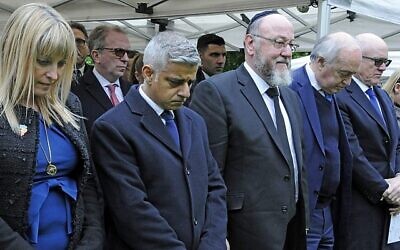
He and the archbishop have since forged a close friendship. Both have lost daughters – Welby’s seven-month-old child, Johanna, died in a car crash in 1983 – and appeared together on BBC Radio 4’s Today Programme to talk about how they live with grief.
The Chief Rabbi suddenly reclines in his chair and says: “Oh, I must tell you a funny story about the Kotel…” I get the distinct impression he’s forgotten he doesn’t like talking about himself. I don’t remind him. When it comes to his cherished Kotel, his walls are down.
“So…” he smiles, relishing the opportunity to reminisce. “There’s has been a continuous presence at the Kotel ever since 1967 [when Judaism’s holiest site returned to Jewish control for the first time in 2,000 years]. A group called Chevrat Mishnayot holds 24/7 study sessions there. It’s a symbol of Jewish commitment to the site, of the handing over of its care to future generations and the fact it represents every one of us. It’s an important tradition.
“Well, there was a heavy snowstorm in Jerusalem during Purim in 1981. I said to Valerie, I’m going to the Kotel to pray. She replied, ‘Are you crazy? In this weather?!’ but off I went.
“I arrived, thick snow falling, I couldn’t see a single person. The Kotel looked abandoned. Suddenly, a figure ran towards me through the blizzard and yelled, “Thank God you’ve arrived! I’ve been stuck here waiting for somebody to come for ages!” Then he ran off. So, there I am at the Kotel, immersed in a unique spiritual experience. I was the link preserving this historic chain all on my own.
“After about half an hour I realised Valerie would be wondering where I was so, as the snow fell, my prayers changed to, ‘Please God, send someone!’ Eventually someone else did turn up. I ran up to them, said, “Thank God you’ve arrived,” and left. The message I took from that day was the sense of responsibility we have to stand as a link in the chain of the Jewish people. It has always stayed with me.”
My favourite time of day is early morning, around 5am, when I’m surrounded by silence, the phone doesn’t ring and have time to really think
The following year he left Israel to become rabbi of Dublin’s Adelaide Road Synagogue (which closed in 1999) and, three years later, Chief Rabbi of Ireland. “Being Chief Rabbi of Ireland is like being Prince of Monaco,” he says. “It’s a huge role in a small place (Ireland has a Jewish population of just 2,500). I met with the president and visiting statesmen and dealt with important national and religious issues. It prepared me in many ways for the role I have today.”
Had this path to the rabbinate not been set in the stars, might he have pursued an alternative career? A lawyer, accountant… Tottenham Hotspur midfielder playmaker? “Well, thanks for thinking I might have received such greatness,” he smiles at the thought. “The only other career I might have pursued is music, which is central to every person who strives for spirituality. Cantorial music helped train my voice in yeshiva and it’s something I enjoy enormously.”
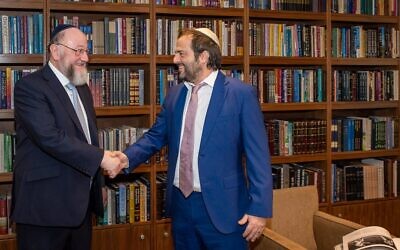
How about pop music? Beatles or Stones? “The Beatles. I remember when Beatlemania hit South Africa and we swapped bubblegum wrappers with pictures of the band to collect a full set.” Lennon or McCartney? “Definitely McCartney. Another singer I liked from that time was Manfred Mann. You know… 5-4-3-2-1 and The Mighty Quinn. Well, it just so happens that Manfred is Valerie’s cousin. Of course, I didn’t know at the time when I when I was growing up listing to his music that I’d be related to him one day.”
On to the unexpected knighthood. How did you find out, what did Valerie say and, most, importantly, what colour tie will you wear? “I remember it clearly. It was 30 November and I was visiting King David High School in Liverpool. I had just spoken to the pupils and was sitting in the headteacher’s office when the email arrived. I needed to read it a few times to appreciate what it meant. I didn’t know what KBE (Knight of the Most Excellent Order of the British Empire) stood for so I Googled it. It is wonderful, humbling recognition of the importance of the Jewish community in this country.”
The King will spend quite a bit of quality time with the Chief Rabbi and Valerie in the coming months, as they are booked in for a sleepover at Clarence House, less than a mile from Westminster Abbey, the night before the coronation on 6 May to avoid travelling on Shabbat.
He says: “It was a lovely gesture from the King and Queen Consort to invite us to stay. They are providing a kosher caterer and making all the Shabbat preparations.”
The tradition of the Chief Rabbi attending the new monarch’s coronation harks back to Hermann Adler’s presence at the coronation of King Edward VII in 1902, which also took place on Shabbat. Chief Rabbi Israel Brodic had no such concerns for the coronation of Queen Elizabeth II in 1953, held on a Tuesday.
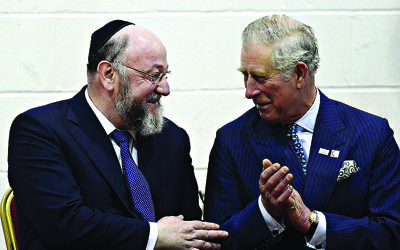
Last November, Rabbi Mirvis marked the first official visit to an Arab state in his office’s 318-year history by delivering the opening address at the Abu Dhabi Forum for Peace in the United Arab Emirates (UAE). Seated next to the forum’s founder, Sheikh Abdullah bin Bayyah, one of the world’s most revered Muslim scholars, he told an audience of 500 religious and political leaders that “a window of opportunity has been opened for Jewish-Muslim relations”.
The UAE is the only place in the world with a minister of tolerance – he invited the Chief Rabbi to his home for lunch during the trip.
He reflects: “When I meet religious or political leaders, I tend to ask myself: are they genuine or just saying all the right things? Well, the warmth between Jews and Muslims in Abu Dhabi was palpable. The outpouring of friendship and hospitality was not scripted. When you meet someone like Sheikh Ahmed Obaid Al Mansoori, who has dedicated his life to running the Arab world’s first Holocaust museum, you know you are in the presence of someone genuinely sincere. It was a deeply moving experience.”
The UAE is the only place in the world with a minister of tolerance (he invited the Chief Rabbi to his home for lunch during the trip). Under this minister’s watch, the Abrahamic Family House, consisting of a mosque, a synagogue and a church, has just been opened.
The Chief Rabbi addressed the opening ceremony and fixed a mezuzah on what was the first purpose-built synagogue in the Arab world for nearly a century. “The UAE genuinely wants to be at the heart of global interfaith. It is investing a lot in bringing Jews, Muslims and Christians together. This is so refreshing because many aspects of European society appear to be heading in the opposite direction with an increase in xenophobia and antisemitism. We need to seize this opportunity.”
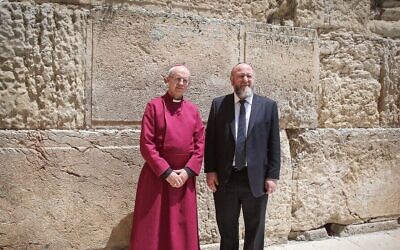
Back home, how would he characterise current relations between Orthodox and non-Orthodox Jews? “To use another cricketing analogy, we must be batsmen not bowlers,” he says. “We must stand up for what we represent, be proud of our achievements and score runs for our side without trying to get the other side out. I made it clear on becoming Chief Rabbi that I would never publicly criticise non-Orthodox Jews. I have good relations with progressive groups, we speak diplomatically and effectively.”
A Land Rover pulls up outside and Mark Frazer, the Chief Rabbi’s head of communications, shoots the boss a “we’re going to be late for your next thing” stare. No rest for the righteous. Just time to shoehorn in a final question.
When, I wonder, do you make moments for yourself? “My favourite time of day is early morning, around 5am, when I’m surrounded by silence, the phone doesn’t ring and have time to really think,” he says. “I also enjoy being on my exercise bike before bed, watching the Sky News newspaper review. I need these moments of quiet to gather my thoughts and clear my mind ready for the next day.”
• This interview was first published in the spring 2023 edition of the United Synagogue’s United magazine. Click HERE to read it

Thank you for helping to make Jewish News the leading source of news and opinion for the UK Jewish community. Today we're asking for your invaluable help to continue putting our community first in everything we do.
For as little as £5 a month you can help sustain the vital work we do in celebrating and standing up for Jewish life in Britain.
Jewish News holds our community together and keeps us connected. Like a synagogue, it’s where people turn to feel part of something bigger. It also proudly shows the rest of Britain the vibrancy and rich culture of modern Jewish life.
You can make a quick and easy one-off or monthly contribution of £5, £10, £20 or any other sum you’re comfortable with.
100% of your donation will help us continue celebrating our community, in all its dynamic diversity...
Engaging
Being a community platform means so much more than producing a newspaper and website. One of our proudest roles is media partnering with our invaluable charities to amplify the outstanding work they do to help us all.
Celebrating
There’s no shortage of oys in the world but Jewish News takes every opportunity to celebrate the joys too, through projects like Night of Heroes, 40 Under 40 and other compelling countdowns that make the community kvell with pride.
Pioneering
In the first collaboration between media outlets from different faiths, Jewish News worked with British Muslim TV and Church Times to produce a list of young activists leading the way on interfaith understanding.
Campaigning
Royal Mail issued a stamp honouring Holocaust hero Sir Nicholas Winton after a Jewish News campaign attracted more than 100,000 backers. Jewish Newsalso produces special editions of the paper highlighting pressing issues including mental health and Holocaust remembrance.
Easy access
In an age when news is readily accessible, Jewish News provides high-quality content free online and offline, removing any financial barriers to connecting people.
Voice of our community to wider society
The Jewish News team regularly appears on TV, radio and on the pages of the national press to comment on stories about the Jewish community. Easy access to the paper on the streets of London also means Jewish News provides an invaluable window into the community for the country at large.
We hope you agree all this is worth preserving.
- News
- UK News
- Feature< Interview
- Sir Ephraim Mirvis
- Chief Rabbi
- Isrel
- Jewish
- Judaism
- United Synagogue
- Richard Ferrer
- Rabbi Lord Sacks
- UAE
- United Arab Emirates
- South Africa
- Nelson Mandela
- religion
- King
- coronation
- King Charles
- Jerusalem
- western wall
- kotel
- Jewish News
- paul mccartney
- beatles
- Irish Jewish Museum
- Ireland
- Justin Welby
- Tottenham Hotspur

